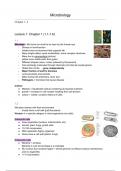Microbiology
Chapter 1, 4
Lecture 1: Chapter 1 (1.1-1.6)
1.1
Microbes = life forms too small to be seen by the human eye
- Diverse in form/function
- Inhabit every environment that supports life
- Many single-celled, some multicellular, some complex structures
- Many live in communities (picture)
yellow more visible parts than green
- Different shapes/ sizes / colors (stained by fluorescent)
- Can exchange molecules through channels (vili) (last pic purple-green)
- Oldest form of life – grow independently
- Major fraction of earth's biomass
- surround plants and animals
- affect human life (infections, food, etc)
- Pathogens = microbes that cause disease
Culture
● Medium = liquid/solid mixture containing all required nutrients
● growth = increase in cell number resulting from cell division
● colony = visible; contains millions of cells
1.2
Microbes interact with their environment
- mostly have a cell wall (just like plants)
Viruses ⇒ a special category in microorganisms (not cells)
Eukaryotic cells
● have organelles (nucleus, mitochondria, etc)
● Animal, plant, fungi, protist cells
● 10-100 micrometers
● DNA replication highly organized
● Some have a cell wall (plants, fungi)
Prokaryotic cells
● Bacteria + archaea
Bacteria is oval and archaea is a rectangle
● No nucleus (but nucleoid region = where genome is (without nucleus membrane))
and no organelles
● <1-5 micrometers
, ● replicates entire genome at once
● One long single loop of DNA
● Cytoplasmic membrane
● grow faster
● All have a cell wall
● Microbes mostly Prok (fungus are Euk)
● May contain Plasmids (antibiotic resistance)
What all cells have in common
- Cytoplasmic cell membrane
- Cytoplasm (mixture of macromolecules, small organics, ions and ribosomes
- Ribosomes
- Cell wall (strength)
Microorganisms have ability to sense and respond to changes in their environment
● Microbial cells capable of motility (movement), by self-propulsion → respond to
environmental conditions
All cells:
- Structure
- Metabolism
- Growth
- Evolution
Some cells
- Differentiation (spore) → some microbes modify structures to form specialized cells
- Communication (chemical messengers) (donor cell sending DNA to recipient cell)
- Motility
,1.3
Morphology = cell size and shape
- 1 micrometer → 1-million of a meter
- Prokaryotic cells → 0.2-600 micrometer (most are 0.5-10)
Exceptions : Epulo Piscium fishelsoni and Thiomargarita namibiensis
- Eukaryotic cells → 5-100 micrometer
Examples of some cells morphology (largest to smallest)
Large exceptional bacteria:
Epulo Piscium fishelsoni (a)
- 600 micrometer
Thiomargarita namibiensis (b)
- 400-750 micrometer
- sulfur
Small vs Big
advantages small:
- more surface area relatively to volume (decreases
Surface/Volume ratio)
- support greater nutrient and waste product exchange per unit cell
volume
- more efficient than larger cells
- Big → limited in transport
- grow faster → transport molecules over membrane more quick
Common morphologies:
, ● coccus (1.5 um) : spherical or ovoid
● rod/bacillus (1 um): cylindrical
● spirillum (1 um): flexible spiral
● spirochete (0.25 um): long rigid spiral
● appendaged bacteria (1.2 um): stalk and hyphae → thin with spiral or bulbous ends
(irregular/asymmetrical (budding))
● Filamentous (0.8 um): string like
- some stay grouped/ clustered after cell division in distinctive shapes
1.4
Domains: Euk, Bac, Arch
Virus = group of microorganisms that lack cellular structure
- bacteriophages = viruses that kill bacteria
Microorganisms vary greatly in size and shape:
Bacteria
- prokaryotes
- usually undifferentiated single cells 0.5-10
micrometer long (but vary widely)
- 80+ phylogenetic lineages (phyla)
- diverse in appearance, size, function
Archaea
- prokaryotes
- 5 well described phyla
- historically associated with extreme
environments (but not all extremophiles)
- lack known parasites or pathogens of plants
and animals
- 12+ phyla
Eukarya
- plants, animals, fungi
- first were unicellular → endosymbiosis theory
- at least 6 kingdoms (instead of phyla)





